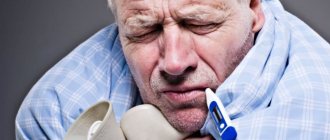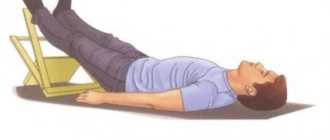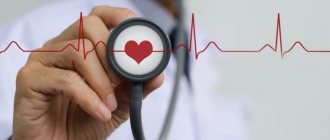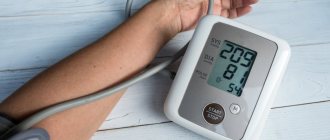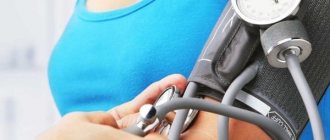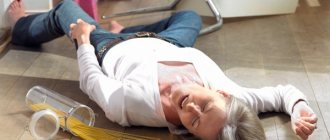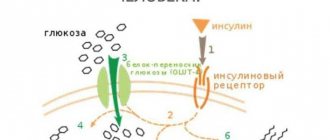What to do if you have a high heart rate and low blood pressure? This question worries a large number of people who are faced with this problem. While there are many medications for high blood pressure, it is much more difficult to increase low blood pressure. To successfully treat a person, it is necessary to understand the reasons underlying such changes in pressure and pulse and establish an accurate diagnosis. It is about the causes and symptoms that arise against the background of a high pulse and low blood pressure that we will talk about today in our article. We will also touch on first aid issues in case of emergency conditions: excessive drop in blood pressure, or a sharp increase in pulse.
What does an increase in heart rate due to hypotension mean?
Doesn't mean anything at all.
Low blood pressure and high heart rate are not related to each other. These are two different processes. Tachycardia is based on irritation or stimulation of a special reflexogenic zone of the heart.
As a result, the organ begins to work more actively. Whether such an influence occurs from the outside or is endogenous in nature needs to be examined separately.
Hypotension is caused by a lot of reasons, often extracardiac. The main factor is a drop in hemodynamics (blood flow) at a general level.
To compensate for the lack of force of heart contractions, the organ is given a signal to speed up its activity.
Causes of tachycardia leading to decreased blood pressure
In some patients, low blood pressure occurs because the heart rate is too high. This is due to the fact that with a rapid heartbeat, the heart does not have time to fill with blood, as a result of which the amount of blood it ejects with each contraction decreases and blood pressure decreases.
A rapid pulse, which causes a drop in blood pressure, is quite rare. Such tachycardia, as a rule, develops suddenly, against the background of ischemic disease or the presence of pathological pathways of the cardiac conduction system. Most often, a rapid pulse caused by fear, pain, increased body temperature, or physical activity does not cause a decrease in blood pressure.
Reasons are physiological
The list of factors in the formation of both processes is wide. The most common ones should be cited:
- Alcohol abuse. The more alcohol a person consumes, the higher the likelihood of developing a paired pathological process.
Alcohol stimulates the third reflexogenic zone of the heart, while at the same time narrowing of large blood vessels occurs. Hence the hemodynamic disturbance.
The blood has to overcome more resistance and the heart begins to beat more actively.
Paradoxically, the higher the pulse, the lower the pressure. This is true starting at 180 beats per minute. Therefore, chronic alcoholics have low blood pressure and hypotension.
- Substance abuse. Including drugs and nicotine. They have the ability to “accelerate” the cardiovascular system.
In the first stage, the pressure increases. Then it drops sharply.
In this case, it is not the tachycardia itself that is dangerous, but a sharp jump in the tonometer reading. This is fraught with a stroke or heart attack.
- Use of tonics and substances. Like caffeine. Tonic components act differently on each body. A decrease in pressure is possible, an increase in the indicator is possible. But the pulse always accelerates.
- Senile age, lack of movement. Often these factors coincide. Bedridden patients of the older age group suffer from this pair of symptoms more often, since the heart cannot cope with the load.
- Abuse of antihypertensive drugs, especially beta blockers and diuretics. The heart begins to race, but the pressure drops.
The reaction is paradoxical, but this is only at first glance. In fact, everything is natural: in order to compensate for the lack of force of heart contractions, the organ begins to accelerate its activity. This indicates a lack of heart fitness.
Pathological causes
- Thyroid disease. The so-called hyperthyroidism. Provokes an increase in heart rate.
Often, against the background of pathology, there is an increase in blood pressure, but in experienced hypotensive patients the effect is exactly the opposite, which is associated with the characteristics and adaptive mechanisms of the body.
It is difficult not to notice hyperthyroidism; all the characteristic symptoms are present. The quality of life drops significantly, the patient is forced to see a doctor.
- Diseases of the adrenal glands such as inappropriate production of corticosteroid substances. First of all, cortisol, a substance that directly affects vascular tone.
To compensate for the lack of blood circulation (the blood vessels in this case are dilated), the heart begins to accelerate and the pulse rate increases. This occurs in Addison's disease.
The opposite is also possible, when there is too much cortisol. As a result of tumors of the adrenal glands themselves or the pituitary gland. The result is the same in both cases.
- General endocrine diseases. First of all, diabetes mellitus in the phase of decompensation or partial compensation. A disease that is under control behaves calmer.
- Pathologies of the heart itself. More often, congestive heart failure occurs with symptoms of malnutrition of the myocardium and other anatomical structures.
This is a dangerous condition, it fails due to hypotension and tachycardia in combination.
The essence of the disorder is the weak force of contractions, which the organ tries to make up for with frequency - hence the strong heartbeat, and the pressure indicator is reduced.
Need medical help before it's too late. The next natural step is a heart attack.
- Vascular pathologies. The most common is atherosclerosis. This is a complex pathology associated with the development of stenosis (narrowing) or blockage of the lumen of a hollow structure by a cholesterol plaque.
The heart has to pump more blood to overcome the increased resistance of the arteries - which is why the pressure is low and the pulse is high.
Contrary to the belief that only hypertension develops against the background of atherosclerosis, this is not so. The reverse process is also possible.
Tachycardia is always present, which indicates excessive tension in the heart.
- Diseases of the circulatory system associated with pathologies of the musculoskeletal system. Osteochondrosis and vertebrobasilar insufficiency. Here are the two most common pathologies.
- Stroke during early rehabilitation. After an acute cerebrovascular accident, both described conditions are quite natural.
But the patient’s condition must be carefully monitored to prevent relapse. This scenario is very likely. After a stroke, your blood pressure may drop.
- Heart attack and post-infarction state.
- Kidney problems. Various types: nephropathies, congestive processes, glomerulonephritis, pyelonephritis and nephritis, also malignant processes, tuberculosis and infectious diseases.
They always lead to disruption of the cardiovascular system due to changes in hemodynamics (blood flow) affecting the whole organism.
- Brain injuries, including concussions of cerebral structures.
- Oncological processes in the body. They manifest themselves in different ways, including a couple of the symptoms described.
All described pathologies require mandatory diagnosis. Verification (confirmation) and timely treatment.
To believe that tachycardia against the background of low blood pressure is not dangerous is at least naive.
The nutrition of the heart muscle is disrupted, and the organ wears out. It is deadly and in 20% of cases without treatment it ends in death in the short term (up to 5 years).
Is it worth risking your health or is it better to see a doctor after spending a few hours?
Normal pulse and blood pressure readings
Every person has two types of blood pressure (BP): systolic (upper) and diastolic (lower). The first is observed in a person at the moment of systole - the maximum tension of the heart when pushing out blood. Diastolic pressure is determined when the heart muscle relaxes - diastole. Values of 120/80 mmHg are considered normal. Art., but different indicators are comfortable for each person .
Some people feel good with slightly elevated blood pressure, others with slightly lower blood pressure. Regardless of this, there are pressure indicators that are already considered a pathology:
| Type of blood pressure | Pressure readings (systolic/diastolic), mm Hg. Art. | Notes | |
| Minimum | Maximum | ||
| Increased slightly | 121/81 | 129/84 | Normal blood pressure |
| Perfect | 100/65 | 120/80 | |
| Decreased slightly | 90/60 | 99/64 | |
| Decreased | 70/40 | 89/59 | Moderate hypotension |
| Significantly decreased (severe hypotension) | 50/35 | 69/39 | Such blood pressure levels are considered dangerous. |
| Extremely low (severe hypotension) | Below 50/35 | ||
From the data in the table it follows that hypotension (hypotension) is considered to be pressure with readings less than 90/60 mmHg. Art. Pulse refers to the vibrations of arterial walls associated with cardiac cycles. This characteristic of the cardiovascular system also has its own indicators of normality and deviations:
| Age, years | Normal heart rate, beats per minute | Notes |
| 20-40 | 65-70 | Tachycardia is considered an increase in heart rate (HR) above 90 beats/min. It can be physiological, which is associated with physical exertion, stress, fear, and pathological – it occurs at rest for one reason or another. When the heart rate decreases to a level of 60 beats/min or less. The patient is diagnosed with bradycardia. |
| 40-45 | 70-75 | |
| 45-55 | 75-78 | |
| Above 70 | 78-80 |
Is this condition dangerous and why?
The causes of low blood pressure and high pulse are dangerous in themselves. Is tachycardia a threat? Without a doubt.
Why is this pathological condition so scary:
- Blood clots are likely to form, since red blood cells begin to die and blood clots directly in the vessels. Depending on the nature of the immediate circulation, a thrombus can get anywhere, into the aorta, pulmonary artery. This is certain death, and almost instantaneous. Measures must be taken to prevent thromboembolism.
- The heart may suddenly stop. It is practically impossible to help the patient in such a case. Resuscitation measures are required. Without the proper skills, nothing will work.
- Acute cardiogenic shock is possible as a result of a further drop in blood pressure. This is also a cause of death.
- With a prolonged course of tachycardia, general metabolic (metabolic) processes in the body are disrupted. Immunity decreases, a person becomes vulnerable to oncology and infectious diseases.
- A high pulse with low pressure can provoke a heart attack, since the nutrition of an already overworked heart is reduced. Read about the signs of a pre-infarction condition here.
Prevention of adverse events is one of the goals of comprehensive treatment. If your blood pressure is low and your pulse is high at the same time, you need medical attention.
Causes of hypotension leading to high heart rate
Typically, hypotension accompanied by tachycardia in relatively healthy people develops due to a decrease in circulating blood volume (hypovolemia). Hypovolemia can be absolute (true) or relative.
True hypovolemia is a consequence of an absolute decrease in the amount of blood within the vascular bed, which can be caused by dehydration, blood loss, or redistribution of plasma into the intercellular space (so-called “third space” losses).
Relative hypovolemia occurs due to dilation of blood vessels, in which the normal volume of circulating blood becomes insufficient to maintain blood pressure levels.
During hypovolemia, the heart, in response to a decrease in blood pressure, reacts with a compensatory increase in heart rate, which is designed to restore blood supply to vital organs.
In many diseases, a combination of different types of hypovolemia leads to a decrease in blood pressure and an increase in heart rate.
Causes of dehydration
Dehydration can be caused by not drinking enough water or losing too much fluid from the body.
| Causes of dehydration | Characteristic |
| Diarrhea | Diarrhea is the most common cause of dehydration and can be caused by a variety of conditions, including gastroenteritis, enterocolitis, and irritable bowel syndrome. |
| Vomit | May be a consequence of gastroenteritis, gastric paresis, intestinal obstruction, rotavirus infection and other diseases. |
| Sweating | Can lead to dehydration during fever, during physical exertion, especially in high ambient temperatures. |
| Diabetes | Elevated blood glucose levels increase the amount of urine the kidneys excrete. |
| Alcohol | Alcohol has a diuretic effect, which removes large amounts of fluid from the body. |
| Diuretics | These are diuretic medications that are often used to treat high blood pressure and heart failure. |
Causes of blood loss
Blood loss is one of the most dangerous causes of low blood pressure and increased heart rate. It develops with external and internal bleeding, which can be caused by traumatic factors or diseases.
Examples of diseases that may be complicated by bleeding are:
- stomach or duodenal ulcer;
- hemophilia;
- varicose veins of the esophagus due to cirrhosis of the liver;
- bowel cancer and other oncological diseases.
Reasons for the redistribution of plasma into the intercellular space
In some diseases, the liquid part of the blood (plasma) leaves the vascular bed and enters the intercellular space and cavities of the body, which means a decrease in the volume of circulating blood. The reasons for this redistribution may be:
- Decreased protein levels in the blood.
- Kidney diseases.
- Liver diseases.
- Heart failure.
- Severe burns.
Causes of relative hypovolemia
With relative hypovolemia, the existing blood volume is insufficient to fill the dilated vascular bed. Its most dangerous causes are sepsis (blood poisoning) and severe allergic reactions (anaphylactic shock). Both of these diseases are accompanied by a decrease in blood pressure and a compensatory increase in heart rate.
How to lower your heart rate at home
Is it even possible to do anything on our own? If the patient has not been to a cardiologist and has not received clear instructions in this regard, it is necessary to call an ambulance.
Tachycardia lasting more than 2 minutes is considered pathological. Before the doctors arrive, you need to try to do something using non-drug methods.
- For example, take a horizontal position, breathe slowly and evenly, holding your breath for a few seconds as you exhale.
- If the pressure has decreased and the pulse has increased more than 120 beats. per minute You can take a few tablets of mild sedatives of herbal origin. Valocordin or Corvalol will help (there are no contraindications for use in this case).
But no beta blockers or any serious pharmaceuticals. It is not known how such amateur activity will turn out.
The issue of hospitalization of the patient for further examination is decided on the spot.
Whether to agree or not is up to the person to decide. But you shouldn't refuse. It is important to find out the reason. This is the only way to prescribe the correct treatment.
Symptoms that require calling a doctor or ambulance
The main pathological manifestation requiring the help of a doctor has already been named. This is tachycardia, that is, a heartbeat of more than 100-120 beats per minute for more than two minutes.
The longer the process takes, the higher the likelihood of complications. The organ is working hard.
In addition to the named sign, the following are considered dangerous:
- Headache. Even the minimum degree of intensity. It shouldn't exist.
- Visual disturbances such as flickering of flies, photopsia (sparks), fog, darkening with sudden movement.
- Dizziness.
- Fainting state. Especially repeatedly.
- Vomiting that does not relieve symptoms. It is reflexive in nature, so it doesn’t get easier.
- Chest pain. They radiate to the epigastric region and do not intensify with movement and breathing.
- Arrhythmia with interruptions in the heart (fading, skipping beats).
- Shortness of breath, suffocation, breathing problems.
- Impaired coordination, attention, confusion.
- Noise in the ears and head.
If there is at least one manifestation, you should contact a cardiology specialist.
Time in this case plays against the patient. Long waits are associated with an increased risk of complications.
First aid
If you experience pain in the chest area, heaviness in the stomach, which is accompanied by headaches and dizziness, you must take a horizontal position. By the way, in such conditions, symptoms such as a feeling of panic and fear, nausea and darkening of the eyes can be observed.
While lying down, you should raise your legs slightly to improve blood flow. If necessary, the patient should be removed from any pressing clothing. If all this happens indoors, then you need to open the window to provide the patient with fresh air.
What to do with tachycardia and hypotension:
- drink one or two cups of sweet tea, adding a little ginseng or lemon tincture;
- in the absence of vomiting, you can alleviate the condition with a few pieces of dark chocolate or a cheese sandwich;
- take a few deep breaths and hold your breath, which will help reduce the number of pulse beats per minute;
- for the same purpose, you can tense your abdominal muscles for 15-20 minutes;
- You can also lower your pulse using this method - lightly press your fingers on your closed eyelids for 20-30 seconds.
If the deterioration in health is insignificant, then simply resting will be enough. But if there is no improvement, you should still visit a doctor.
It is better not to take any medications before the ambulance arrives, so as not to blur the clinical picture. In case of a pronounced hypotonic crisis, you can take one tablet of Citramon.
List of necessary studies
If you have tachycardia, consult a cardiologist. He, at his own discretion, refers the patient to an endocrinologist or neurologist to clarify the etiology of the condition.
The list of studies is quite wide:
- Oral questioning of the patient to objectify complaints and symptoms of a probable disease.
- Anamnesis collection.
- Heart rate assessment. It is carried out in the old-fashioned way by eye or with a special sensor. The second is preferable.
- Measuring blood pressure levels. As a rule, we are talking about a consistently low indicator.
- Daily monitoring. Shows the process over time over 24 hours. Prescribed in all cases.
- Electrocardiography. Profile research. Provides comprehensive information about the nature of cardiac activity. But it requires great qualifications from the diagnostician, which not everyone has.
- Angiography. Vascular examination.
- Assessment of the level of specific hormones in the patient’s blood.
- Examination of neurological status.
The list may be expanded at the discretion of specialists. This is a minimum program.
Additionally, blood tests, urine tests, and tomographic techniques may be prescribed.
What treatment is prescribed?
Most often, treatment is complex and is designed to solve two problems: normalize the patient’s condition and relieve symptoms, as well as eliminate the root cause of the pathological process. Both problems need to be addressed together.
Medicinal and surgical methods are used. The most popular drugs among cardiologists are beta blockers, calcium channel blockers, sedatives and diuretics.
Surgery is indicated for cardiac pathologies and then only in extreme cases.
It is possible to implant a pacemaker or defibrillator (for persistent arrhythmias).
Finally, congenital or acquired heart defects are surgically corrected.
An important point in therapy is the correct lifestyle: smoking as little as possible, it is better to completely give up tobacco products and alcohol in any form.
Eat adequately, that is, no fatty, fried, spicy, salty, processed foods or canned food. Only protein, vegetables, fruits, grains, etc.
You shouldn’t overwork yourself physically, but you can’t sit still either. A set of useful exercises will help solve the issue of physical inactivity.

